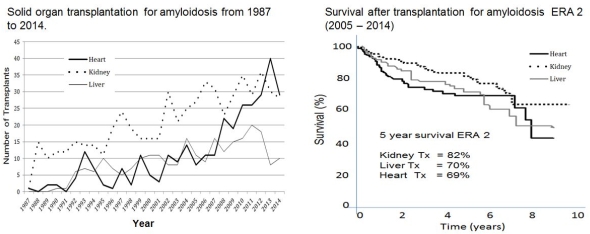Increasing Volume and Improved Survival in Solid Organ Transplantation for Amyloidosis – An Analysis of the UNOS Database.
1University of Utah, Salt Lake City, UT
2Huntsman Cancer Institute, Salt Lake City, UT
3New York-Presbyterian/Columbia University, New York, NY.
Meeting: 2016 American Transplant Congress
Abstract number: B64
Keywords: Heart/lung transplantation, Kidney transplantation, Liver transplantation
Session Information
Session Name: Poster Session B: Disparities in Access and Outcomes
Session Type: Poster Session
Date: Sunday, June 12, 2016
Session Time: 6:00pm-7:00pm
 Presentation Time: 6:00pm-7:00pm
Presentation Time: 6:00pm-7:00pm
Location: Halls C&D
Background: Amyloidosis is a rare disease that results from accumulation of inappropriately folded proteins causing organ failure and poor prognosis. In the last decade several options for therapy have emerged. We hypothesized that the trends and outcomes of solid organ transplantation (Tx) have increased and improved.
Methods: We analyzed the UNOS database and included patients with diagnosis of amyloidosis who received a primary single organ (Kidney, Liver and Heart) or combined organs (Heart-Kidney, Heart-Liver) between January 1987 and September 2014, for either light chain, transthyretin or other amyloidosis. We compared post-transplant outcomes in two separate eras: January 1987 to December 2004 (Era 1) and January 2005 to September 2014 (Era 2).
Results: From 1987 to 2014 a total of 1227 patients with amyloidosis were transplanted: kidney 591(48%), liver 249 (20%), heart 214(17%), heart-liver 50(4%) and heart-kidney 23(2%) (Figure). The five year survival for kidney tx improved from Era1 to Era2 from 66% to 82%, for liver tx from 54% to 70% and for heart tx from 54% to 69% (Figure). In a multivariate analysis, prominent risk factors for 1-year mortality after transplant for amyloidosis included recipient age for kidney (HR 1.06, p 0.01) and mechanical circulatory support (HR 5.42, p = 0.001) and body mass index (HR 0.9, p = 0.05) for heart transplant.
Conclusions: More patients with amyloidosis are considered for solid organ transplantation. Outcomes continue to improve and are now approaching survival rates comparable to non-amyloid patients. 
CITATION INFORMATION: Jaramillo J, Stehlik J, Fang J, Al-Dulaimi R, Gilbert E, Drakos S, Wever-Pinzon O, Selzman C, McKellar S, Kovacsovics T, Abraham J, Maurer M, Nativi-Nicolau J. Increasing Volume and Improved Survival in Solid Organ Transplantation for Amyloidosis – An Analysis of the UNOS Database. Am J Transplant. 2016;16 (suppl 3).
To cite this abstract in AMA style:
Jaramillo J, Stehlik J, Fang J, Al-Dulaimi R, Gilbert E, Drakos S, Wever-Pinzon O, Selzman C, McKellar S, Kovacsovics T, Abraham J, Maurer M, Nativi-Nicolau J. Increasing Volume and Improved Survival in Solid Organ Transplantation for Amyloidosis – An Analysis of the UNOS Database. [abstract]. Am J Transplant. 2016; 16 (suppl 3). https://atcmeetingabstracts.com/abstract/increasing-volume-and-improved-survival-in-solid-organ-transplantation-for-amyloidosis-an-analysis-of-the-unos-database/. Accessed July 18, 2025.« Back to 2016 American Transplant Congress
